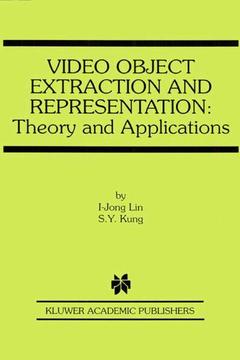Description
Video Object Extraction and Representation, 2002
Theory and Applications
The Springer International Series in Engineering and Computer Science Series, Vol. 584
Authors: I-Jong Lin , Kung S.Y.
Language: English
Subjects for Video Object Extraction and Representation:
Keywords
MPEG; MPEG-4; Standard; Standards; computer; information; multimedia; network; video
Approximative price 105.49 €
In Print (Delivery period: 15 days).
Add to cart
Video Object Extraction and Representation
Publication date: 03-2013
177 p. · 15.5x23.5 cm · Paperback
Publication date: 03-2013
177 p. · 15.5x23.5 cm · Paperback
Approximative price 105.49 €
Subject to availability at the publisher.
Add to cart
Video object extraction and representation, theory and applications
Publication date: 09-2000
177 p. · 15.5x23.5 cm · Hardback
Publication date: 09-2000
177 p. · 15.5x23.5 cm · Hardback
Description
/li>Contents
/li>
?If you have built castles in the air, your work need not be lost; that is where they should be. Now put the foundations under them. ? - Henry David Thoreau, Walden Although engineering is a study entrenched firmly in belief of pr- matism, I have always believed its impact need not be limited to pr- matism. Pragmatism is not the boundaries that define engineering, just the (sometimes unforgiving) rules by which we sight our goals. This book studies two major problems of content-based video proce- ing for a media-based technology: Video Object Plane (VOP) Extr- tion and Representation, in support of the MPEG-4 and MPEG-7 video standards, respectively. After reviewing relevant image and video p- cessing techniques, we introduce the concept of Voronoi Ordered Spaces for both VOP extraction and representation to integrate shape infor- tion into low-level optimization algorithms and to derive robust shape descriptors, respectively. We implement a video object segmentation system with a novel surface optimization scheme that integrates Voronoi Ordered Spaces with existing techniques to balance visual information against predictions of models of a priori information. With these VOPs, we have explicit forms of video objects that give users the ability to - dress and manipulate video content. We outline a general methodology of robust data representation and comparison through the concept of complex partitioning mapped onto Directed Acyclic Graphs (DAGs).
Preface. Explanation and Index of Outline Pages. Acknowledgments. 1. Introduction to Content-Based Visual Processing. 2. Existing Techniques of Visual Processing. 3. Voronoi Ordered Space. 4. A System for Video Object Segmentation. 5. Robust Representation of Shape with Dags. 6. A System for Image/Video Object Query by Shape. 7. The Future of Content-Based Video Processing. Index.
© 2024 LAVOISIER S.A.S.




